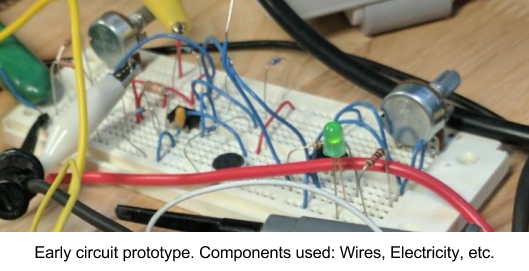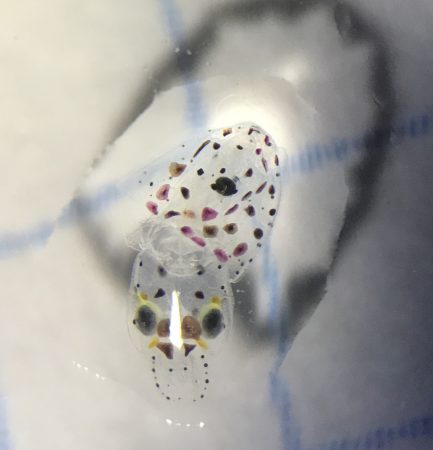-
 EducationHi everyone! The summer is finally coming to a close and I am excited to share all that I have learned from my time as a Backyard Brains fellow with you. If you’ve been here since the beginning, thank you so much for following along with me and my squiddos for the past ten weeks […]
EducationHi everyone! The summer is finally coming to a close and I am excited to share all that I have learned from my time as a Backyard Brains fellow with you. If you’ve been here since the beginning, thank you so much for following along with me and my squiddos for the past ten weeks […] -
 EducationToday our Summer Research Fellows “snuck in” and presented their summer work at a University of Michigan, Undergraduate Research Opportunity Program (UROP) symposium! Over the two sessions our fellows presented their work and rigs to judges, other students, to university faculty, and community members. Some of the fellows are seasoned poster designers, but others had […]
EducationToday our Summer Research Fellows “snuck in” and presented their summer work at a University of Michigan, Undergraduate Research Opportunity Program (UROP) symposium! Over the two sessions our fellows presented their work and rigs to judges, other students, to university faculty, and community members. Some of the fellows are seasoned poster designers, but others had […] -
 EducationG’day mate, how are ya? Thank you for waiting for the updates on my research on Human EEG Decoding (aka Mind Reading). Since my last post, I have tried to decode human EEG data in real time and… guess what…I succeeded! Hooray! I first analyzed all the data I have collected so far to verify […]
EducationG’day mate, how are ya? Thank you for waiting for the updates on my research on Human EEG Decoding (aka Mind Reading). Since my last post, I have tried to decode human EEG data in real time and… guess what…I succeeded! Hooray! I first analyzed all the data I have collected so far to verify […] -
 EducationHi, the electric fish project is going swimmingly! I designed a bandpass filter circuit with cut-off frequencies = 159.155 Hz and 15.9155 kHz to remove unwanted noise from the recorded electric organ discharges (collected using electrodes placed close to the elephant nose fish inside the fish tank), and an amplifier with a gain of around […]
EducationHi, the electric fish project is going swimmingly! I designed a bandpass filter circuit with cut-off frequencies = 159.155 Hz and 15.9155 kHz to remove unwanted noise from the recorded electric organ discharges (collected using electrodes placed close to the elephant nose fish inside the fish tank), and an amplifier with a gain of around […] -
 EducationHello my friends, This is the 4th edition of the Backyard Brains World Tour. Just a short reminder: my name is Etienne ‘ÉT’ Serbe and I’m currently travelling in South America to spread the word of Neuroscience. After nearly 20 presentations, workshops, or demonstrations of Neuroscience basics in Brasil, Uruguay, Argentina, Chile, and Peru, I […]
EducationHello my friends, This is the 4th edition of the Backyard Brains World Tour. Just a short reminder: my name is Etienne ‘ÉT’ Serbe and I’m currently travelling in South America to spread the word of Neuroscience. After nearly 20 presentations, workshops, or demonstrations of Neuroscience basics in Brasil, Uruguay, Argentina, Chile, and Peru, I […] -
 EducationHey there! Zach here with the Songbird Identification project for a quick update. Since the last post, I’ve been hard at work creating a prototype device to listen for and record songbirds. I began by creating a small circuit using a microphone and amplifier chip. This acts as a sound recorder and also includes circuitry […]
EducationHey there! Zach here with the Songbird Identification project for a quick update. Since the last post, I’ve been hard at work creating a prototype device to listen for and record songbirds. I began by creating a small circuit using a microphone and amplifier chip. This acts as a sound recorder and also includes circuitry […] -
 EducationOh hey there! Long time no see, why don’t you have a seat and hear what I’ve been up to since my last blog update. If you were at the Ann Arbor 4th of July parade you might have seen me dressed up as a beautiful purple octopus (or maybe it was a squid? The […]
EducationOh hey there! Long time no see, why don’t you have a seat and hear what I’ve been up to since my last blog update. If you were at the Ann Arbor 4th of July parade you might have seen me dressed up as a beautiful purple octopus (or maybe it was a squid? The […] -
 EducationHello everyone! It’s a been over a month since my project began on studying the diet and attempting taste manipulation of the Drosophila melanogaster. Before my experiments could begin I faced many software and hardware issues. The flyPAD itself is an extremely thin 0.6mm PCB board so every slight bend of it can result in […]
EducationHello everyone! It’s a been over a month since my project began on studying the diet and attempting taste manipulation of the Drosophila melanogaster. Before my experiments could begin I faced many software and hardware issues. The flyPAD itself is an extremely thin 0.6mm PCB board so every slight bend of it can result in […] -
 EducationChanging Course In my last post, I talked about how I was essentially replicating the Paloma article (previously linked) in a DIY manner. This is no longer the case. The primary goal at this point is to record from the TSDN tracts, located on the ventral portion of the dragonfly’s “neck” area (seen as two […]
EducationChanging Course In my last post, I talked about how I was essentially replicating the Paloma article (previously linked) in a DIY manner. This is no longer the case. The primary goal at this point is to record from the TSDN tracts, located on the ventral portion of the dragonfly’s “neck” area (seen as two […] -
 EducationG’day again! I’ve got data… and it is beautiful! More on this below… I am pleased to update my progress on my BYB project, Human EEG visual decoding! If you missed it, here’s the post where I introduced my project! Since my first blog post, I have collected the data from 6 subjects with the […]
EducationG’day again! I’ve got data… and it is beautiful! More on this below… I am pleased to update my progress on my BYB project, Human EEG visual decoding! If you missed it, here’s the post where I introduced my project! Since my first blog post, I have collected the data from 6 subjects with the […] -
 EducationAre you fast enough to catch a grasshopper with your bare hands? Might be tricky, because grasshoppers are quick to react to potential threats! This reaction time is thanks to a very specific, visual neural circuit in the grasshopper. By recording from this circuit in a living grasshopper prep, we can record the spikes that […]
EducationAre you fast enough to catch a grasshopper with your bare hands? Might be tricky, because grasshoppers are quick to react to potential threats! This reaction time is thanks to a very specific, visual neural circuit in the grasshopper. By recording from this circuit in a living grasshopper prep, we can record the spikes that […] -
 EducationIntroduction to the project … Hi, everyone! Last week marked the halfway point of my time as a fellow here at Backyard Brains! Recently, I’ve succeeded in building a rig and recording video footage of my Squid Hatchlings! I’m excited because it means I can start gathering quantifiable data! The squiddos have kept me pretty busy during […]
EducationIntroduction to the project … Hi, everyone! Last week marked the halfway point of my time as a fellow here at Backyard Brains! Recently, I’ve succeeded in building a rig and recording video footage of my Squid Hatchlings! I’m excited because it means I can start gathering quantifiable data! The squiddos have kept me pretty busy during […]